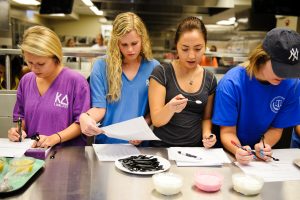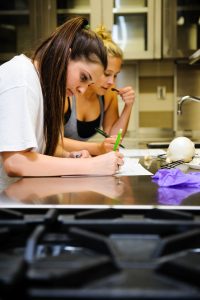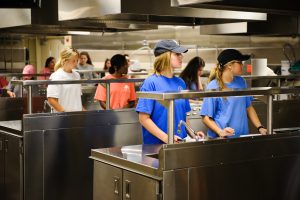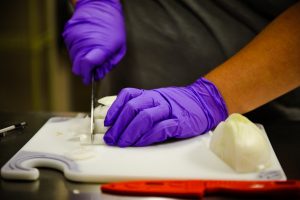Note to Editors and News Directors: A Media Availability Day will be held from 2:45 p.m. to 4:30 p.m. Thursday, Sept. 19, in the foods lab, which is located on the ground floor of Doster Hall. Video and photograph opportunities include students in the lab working on vegetable pH and pigmentation chemistry. They will also be studying the impact of cooking on color. There will be interview opportunities with students and faculty. Contact Kim Eaton, 205/348-8325 or kkeaton@ur.ua.edu, in advance if you plan to attend. Broadcast media should contact Shane Dorrill, 205/348-8319 or sdorrill@ur.ua.edu, or Bill McDaniel,205/348-8327, bmcdaniel@ur.ua.edu. Additional high-resolution photos are available upon request.

TUSCALOOSA, Ala. – It’s all about food, says one University of Alabama professor.
“Food is the core of nutrition, and it’s an integral part of the hospitality industry,” said Dr. Mary Kay Meyer, professor and chair of the human nutrition and hospitality management program in UA’s College of Human Environmental Sciences.
“We talk about what food does to the body, but if you can’t get the food into the body, you’ve lost the battle,” Meyer said. “I want students to be excited about food and really appreciate what you can do with food, if you have the right equipment.”
Students enrolled in food and nutrition courses should have no problem garnering some enthusiasm this semester, thanks to the recently completed $1.5 million state-of-the-art foods lab located on the ground floor of Doster Hall.

Students will not only have access to the traditional gas ranges and conventional ovens, they will get to experiment with induction units, combi-ovens (a combination steaming unit and oven) and a convection oven. They will also have the smaller pieces that every high-quality foods lab needs – pressure cookers and fryers, mixers and more.
Graduate teaching assistant 23-year-old Morgan Patterson, of Demopolis, said most students learn about this equipment in class, but they do not have an opportunity to work with it until they are in the work force.
“Having this opportunity just increases their skill set,” said Patterson. “I was thrilled when I found out they were building the new lab, and I couldn’t wait to see the students firing up the grill. I just knew that first class was going to be a lot of fun.”
The human nutrition and hospitality management program encompasses nutrition majors, as well as hotel, restaurant and meetings management majors. More than 1,200 students are enrolled in the program. The two classes that will initially use the lab are the food science classes – the basic food science class and experimental and functional foods.
Human nutrition and hospitality management are not culinary programs. The courses focus on the science behind food and how principles of food preparation impact nutrient content, taste, texture and appearance.

“Although there are ovens and ranges in this lab, we blend the science experimentation, which uses chemistry lab supplies like beakers, pH strips and titration equipment, with culinary applications,” said Dr. Kristi Michele Crowe, a food chemist, dietitian and assistant professor of nutrition at UA. “In other words, we teach how the concepts of food chemistry are used in the food industry to develop food products, yet the same principles are taking place in one’s own kitchen.”
Last year, the program received a grant from Nestle USA to evaluate the sensory attributes of a protein-enhanced soup. The science behind the grant included evaluating the differences in taste, texture, flow, aroma and overall preference between the tested soups and standard flavor-matched, nonfortified soups, Crowe said. As a result of the data collected, the tested soups will be marketed to long-term care facilities as a means of increasing the protein content in diets of older adults, she added.
“Understanding the science of food has allowed for an explosion of nutritious food choices with reasonably long shelf-lives,” Crowe said. “Without the understanding of the chemistry of macro and micronutrients and the interactions between them, dietitians could not adequately counsel patients on how to modify their diets for health and wellness.

Students can also utilize the new food sensory lab to conduct research studies, like the soup study conducted earlier this year for Nestle USA. Meyer said the department has wanted to build that research component, but this is the first time they have had the facilities to do so.
The audio-visual component of the lab brings a new dimension to the curriculum for the department’s online programs by having taped demonstrations made available to distance-learning students.
In addition, students enrolled in catering and quantity food production courses have utilized the lab to learn operation and safety of commercial cooking equipment, and, in the spring, there will a new food preparation course offered to hospitality majors.
Meyer said the department could also utilize the new lab for hosting seminars, basic cooking courses for the community and more.
“We could do summer camps for children, continuing education programs for food personnel, a series on French cooking,” Meyer said. “The possibilities are endless.”
Contact
Kim Eaton, UA media relations, 205/348-8325, kkeaton@ur.ua.edu
Source
Dr. Mary Kay Meyer, 205/348-4397, mkmeyer@ches.ua.edu